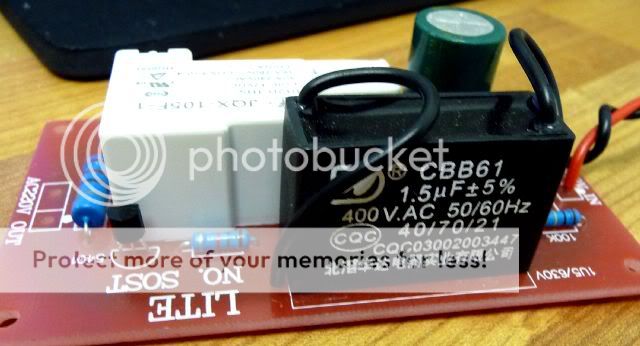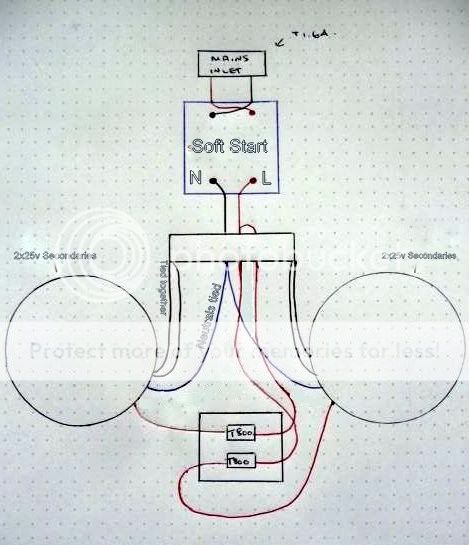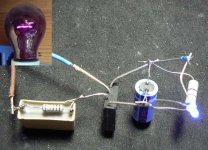If it happened on both primaries at the same time, but not on the secondaries, something must have happened on the primaries. I blew the fuses once on a commercial amp, when I involuntarily switched it on-off-on very fast. The soft-start circuit had not yet bridged the resistors, yet still I had obviously managed to switch the mains on for the second time just when the transformer core was magnetized the wrong way round for the incoming mains. Maybe you have experienced something similar due to contact bouncing from your mains switch.
If it happened on both primaries at the same time, but not on the secondaries, something must have happened on the primaries. I blew the fuses once on a commercial amp, when I involuntarily switched it on-off-on very fast. The soft-start circuit had not yet bridged the resistors, yet still I had obviously managed to switch the mains on for the second time just when the transformer core was magnetized the wrong way round for the incoming mains. Maybe you have experienced something similar due to contact bouncing from your mains switch.
Hi
I don't have any fuses on the transformer secondaries, only the primary winding. What's puzzling me is that both soft-start circuits make the bulb glow. Is a bulb tester compatible with a soft-start module? I recently repaired an LCD monitor, when I attached the bulb to the SMPS it made the bulb flash as it was trying to charge. The power supply was OK.
What is your name by the way?
Happy Christmas!
When you load a transformer, the secondary voltage drops. There can be situations, where the secondary load leads to a balance of voltage and current that does not trip the primary fuses although the secondary current is overloading the transformer. That is, why transformers should always have secondary fuses at or below the transformer's nominal rating.
The light bulb is not a very precise indicator. It is hard to assess how dim or bright it is from a photo. The brightness depends on the bulb wattage, the load and their interaction, and your perception of dim and bright may be different from mine. So it is hard to tell, whether it is okay that the bulb lights up with only the soft-start module connected. although it seems a soft-start module should not be drawing a lot of current on its own. You could try a bigger bulb than 40 W.
If you want to be really sure, you need to measure the current that actually flows and compare it to the device's specifications. Since that involves work on the mains voltage, you should only do it, if you really cannot avoid it and work with utmost care. Use a jumper across the meter, when you switch the power on, and remove it after the inrush current has passed. And be careful not to touch anything live, while testing. The DUT should be connected to a ground fault circuit-breaker and you should keep one hand in your pocket, while working.
Happy Christmas to you, too.
David
The light bulb is not a very precise indicator. It is hard to assess how dim or bright it is from a photo. The brightness depends on the bulb wattage, the load and their interaction, and your perception of dim and bright may be different from mine. So it is hard to tell, whether it is okay that the bulb lights up with only the soft-start module connected. although it seems a soft-start module should not be drawing a lot of current on its own. You could try a bigger bulb than 40 W.
If you want to be really sure, you need to measure the current that actually flows and compare it to the device's specifications. Since that involves work on the mains voltage, you should only do it, if you really cannot avoid it and work with utmost care. Use a jumper across the meter, when you switch the power on, and remove it after the inrush current has passed. And be careful not to touch anything live, while testing. The DUT should be connected to a ground fault circuit-breaker and you should keep one hand in your pocket, while working.
Happy Christmas to you, too.
David
Tested without soft-start circuit
Hi
I have tested the transformers and power supplies with the bulb tester, then each amp. The bulb glows momentary and then goes out completely with the transformers and PS. The same happens when I connect the first amp. When I connect the second amp the bulb filament barely glows...I have to get up close the see if it is lit or not. I guess everything is OK.
I will buy some secondary T1-1.6A fuses tomorrow as these need to be fitted.
Do you think is worth fitting a slightly higher rated fuse on the primary/mains inlet?
So the issue with the soft-start circuit still remains. Is it faulty? I'll email the supplier to see if they can offer some advice and I will report back.
Thanks again for your help.
Hi
I have tested the transformers and power supplies with the bulb tester, then each amp. The bulb glows momentary and then goes out completely with the transformers and PS. The same happens when I connect the first amp. When I connect the second amp the bulb filament barely glows...I have to get up close the see if it is lit or not. I guess everything is OK.
I will buy some secondary T1-1.6A fuses tomorrow as these need to be fitted.
Do you think is worth fitting a slightly higher rated fuse on the primary/mains inlet?
So the issue with the soft-start circuit still remains. Is it faulty? I'll email the supplier to see if they can offer some advice and I will report back.
Thanks again for your help.
The transformer must be protected against two things.
One is overload, which you do on the secondaries with slow-blow fuses rated smaller than or equal to the nominal secondary current. E. g. on a 300 VA transformer with 25-0-25 V you need 300/2/25 = 6 A or smaller fuses. You can use smaller fuses, if the transformer is oversized.
The other is short-circuit. Short-circuit protection must be installed before the primaries and the slow-blow fuses there should be rated as small as possible, but big enough to avoid nuisance blowing. Since a short-circuit means significant current draw, the primary fuses can be bigger than the nominal primary current, as they will be tripped anyhow. A rating of twice or even three times the nominal current is not unusual.
They should however be smaller than the next fuse before them in the circuit and they should be small enough to ensure cable/wire protection according to your local regulations. Or the other way round: once the fuse size is determined, you need to choose the wire diameter big enough to cope with the fuse rating.
The primary fuses should also be big enough not to trip before the secondaries except in the case of a short-circuit in the primary windings or mains wiring.
If the soft-start module draws more current than the amplifier, it is either faulty or extremely bad designed. What strikes me as odd in the photo in post #476 is that a 12 V relay is fitted, when the power supply is 240 V, but no transformer seems to be present. That would mean that 228 V times the relay coil current must be dissipated as heat somewhere, probably something like 17 W or so, yet there does not seem to be any component apt to do that on the PCB.
Regards
David
One is overload, which you do on the secondaries with slow-blow fuses rated smaller than or equal to the nominal secondary current. E. g. on a 300 VA transformer with 25-0-25 V you need 300/2/25 = 6 A or smaller fuses. You can use smaller fuses, if the transformer is oversized.
The other is short-circuit. Short-circuit protection must be installed before the primaries and the slow-blow fuses there should be rated as small as possible, but big enough to avoid nuisance blowing. Since a short-circuit means significant current draw, the primary fuses can be bigger than the nominal primary current, as they will be tripped anyhow. A rating of twice or even three times the nominal current is not unusual.
They should however be smaller than the next fuse before them in the circuit and they should be small enough to ensure cable/wire protection according to your local regulations. Or the other way round: once the fuse size is determined, you need to choose the wire diameter big enough to cope with the fuse rating.
The primary fuses should also be big enough not to trip before the secondaries except in the case of a short-circuit in the primary windings or mains wiring.
If the soft-start module draws more current than the amplifier, it is either faulty or extremely bad designed. What strikes me as odd in the photo in post #476 is that a 12 V relay is fitted, when the power supply is 240 V, but no transformer seems to be present. That would mean that 228 V times the relay coil current must be dissipated as heat somewhere, probably something like 17 W or so, yet there does not seem to be any component apt to do that on the PCB.
Regards
David
Hi David
I am a bit confused regarding the secondary fuses. Andrew quotes much smaller fast blow fuses in the following link
http://www.diyaudio.com/forums/chip-amps/128561-chip-amp-power-supply-beginners-guide-47.html#post2001485
Are you suggesting the fuses be placed before the smoothing capacitors?
Here are some close-up photos of the soft-start




The three transistors on the board are 2N5401
Thanks
I am a bit confused regarding the secondary fuses. Andrew quotes much smaller fast blow fuses in the following link
http://www.diyaudio.com/forums/chip-amps/128561-chip-amp-power-supply-beginners-guide-47.html#post2001485
Are you suggesting the fuses be placed before the smoothing capacitors?
Here are some close-up photos of the soft-start




The three transistors on the board are 2N5401
Thanks
that capacitor is rated 1u5F @ 400Vac and captioned on the pcb @ 630Vdc.
It appears the soft start is using mains voltage and dropping the excess voltage using the capacitor to leak working current through the high impedance of the capacitor. It will pass ~ 100mAac from 240Vac 50Hz.
It's not a nice way to do it, but when competantly designed it does work.
Be careful the soft start is working at mains voltage!!!!
It appears the soft start is using mains voltage and dropping the excess voltage using the capacitor to leak working current through the high impedance of the capacitor. It will pass ~ 100mAac from 240Vac 50Hz.
It's not a nice way to do it, but when competantly designed it does work.
Be careful the soft start is working at mains voltage!!!!
that capacitor is rated 1u5F @ 400Vac and captioned on the pcb @ 630Vdc.
It appears the soft start is using mains voltage and dropping the excess voltage using the capacitor to leak working current through the high impedance of the capacitor. It will pass ~ 100mAac from 240Vac 50Hz.
It's not a nice way to do it, but when competantly designed it does work.
Be careful the soft start is working at mains voltage!!!!
Hi Andrew
Do you think this method of powering the soft-start circuit would cause the bulb to light?
Thanks
Andrew has probably recommended a fuse rating to protect the amplifier. You can add such a protection, although amplifier protection with fuses is not really effective. The fuses are either too big to avoid damage or so small that the amplifier is useless due to continuous nuisance blowing.
Each transformer secondary must have a fuse directly behind it even before the rectifiers. Short-circuits and overload can happen in the wiring, the rectifiers and the capacitor bank, and the primary fuses cannot provide protection in all possible cases.
I don't want to reverse engineer that soft-start module from photos, so let us wait for the manufacturer's response. Maybe it uses a simple type of SMPS to convert the 240 VAC to 12 VDC. If not, it would indeed waste a lot of energy.
David
Each transformer secondary must have a fuse directly behind it even before the rectifiers. Short-circuits and overload can happen in the wiring, the rectifiers and the capacitor bank, and the primary fuses cannot provide protection in all possible cases.
I don't want to reverse engineer that soft-start module from photos, so let us wait for the manufacturer's response. Maybe it uses a simple type of SMPS to convert the 240 VAC to 12 VDC. If not, it would indeed waste a lot of energy.
David
no.
You wired it up wrongly.
Highly likely.

The soft-start came pre built, but without any instructions.
The relay coil is rated with 0,9 W at 12 V, hence draws 75 mA. 240 V x 75 mA = 18 W plus the consumption of the rest of the control circuit. It seems the manufacturer relies on the 1µ5 capacitor to dissipate most of the waste heat. Pretty scary in view of everybody striving for energy efficiency.
Richard, would you publish the manufacturer's name, so that everybody can avoid buying from him?
Richard, would you publish the manufacturer's name, so that everybody can avoid buying from him?
The relay coil is rated with 0,9 W at 12 V, hence draws 75 mA. 240 V x 75 mA = 18 W plus the consumption of the rest of the control circuit. It seems the manufacturer relies on the 1µ5 capacitor to dissipate most of the waste heat. Pretty scary in view of everybody striving for energy efficiency.
Richard, would you publish the manufacturer's name, so that everybody can avoid buying from him?
No, the reactive feed is non-dissipative. See EDN PDF for more information.
- Home
- Amplifiers
- Chip Amps
- Chip amp power supply- a beginners guide
